Onboard Communications
Martinique
01/07/13 14:41
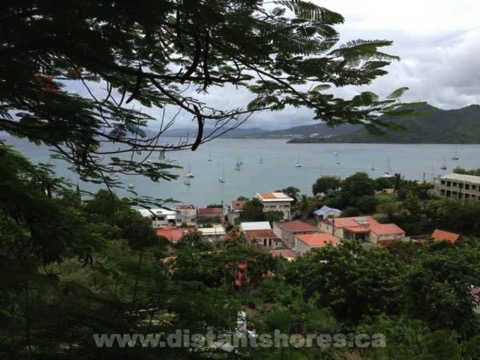
Town of Ste. Anne on the south coast of Martinique
Greetings from the French island of Martinique! July 1st was our national day so yesterday Paul and I celebrated Canada Day anchored off the quaint town of Ste. Anne on the south coast.
We arrived in Martinique, the largest of the Windward Islands, after a great week exploring Dominica, the island to the north (see previous newsletter) and the most southern Caribbean island in the Leeward Islands group.
Leaving Dominica
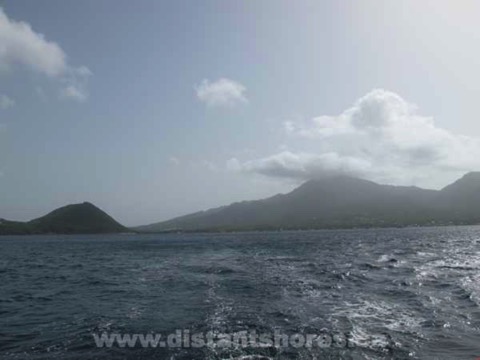
On Sunday June 16 we said goodbye to Dominica and, leaving Portsmouth at 0830, we motored in a southwesterly direction in the lee of the island.
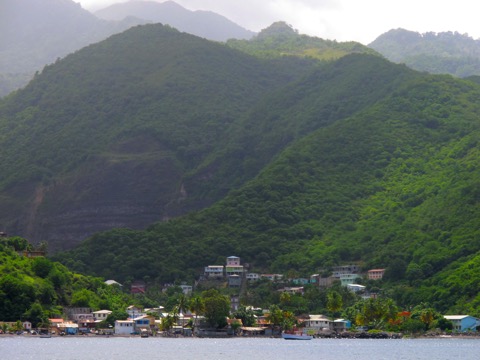
It was a pleasant morning since we kept in fairly close to shore to enjoy the view of the picturesque fishing villages along the dramatic mountainous coast. Our destination was the town of St. Pierre, about 55 nm onwards which is a port of entry on the northwest coast of Martinique. (Note: We didn't need to clear-out when we left Dominica because when you clear-in you are automatically cleared-out two weeks later. You only have to visit Customs and Immigration to clear-out if you stay longer than 2 weeks. Very convenient and welcoming!)
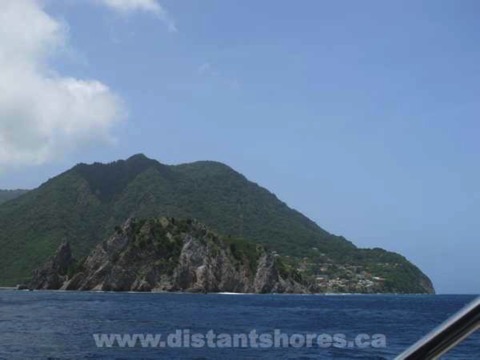
Four hours out from Portsmouth at 1230, we arrived at Scott's Head, a rocky outcrop at the southwest corner of Dominica, and headed out into open water sailing close-hauled for 20 nm across the Martinque Channel. There is an “acceleration zone” here where the wind speed is accelerated as it whirl around the mountainous end of the island. A similar thing happens with the currents. The seas can look rather exciting at this point but smooth out once you get away from land. We had headwinds of 20 knots with gusts to 30 knots, borderline conditions for making this a comfortable passage, and were prepared to turn back and stay the night anchored off Roseau, the capital city of Dominica, if the seas were too nasty. We plowed on but Distant Shores II, our Southerly 49 sailboat, sliced through the seas and we made good progress.
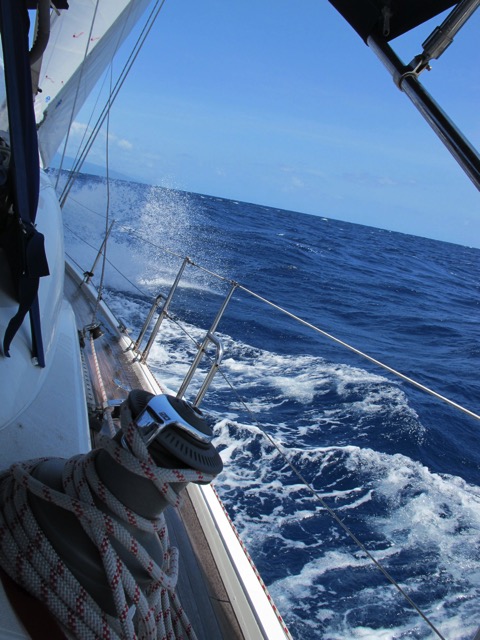
The Martinique Channel divides the Leeward Islands of the Caribbean from the Windward Islands (although some sources include Guadeloupe and Dominica as part of the Windward Islands and make the dividing line further north).
Why are they called the Leeward and Windward Islands? In days of old when sailing ships were the commercial vessels of the time, ships sailing from Europe to the New World would follow the transatlantic currents and prevailing trade winds that blow east to west for the fastest voyage possible. This route would bring ships to roughly the dividing line between the Windward and Leeward Islands so named since the islands to the north were more to leeward for the sailing ships and the group to the south were to windward.
Our main resource for this part of our voyage south through the Caribbean is Chris Doyle's cruising guide, the 2013-2014 Sailors Guide to Windward Islands, and Chris defines the Windward Islands as Martinique, St. Lucia, St. Vincent and the Grenadines, and Grenada.
St. Pierre
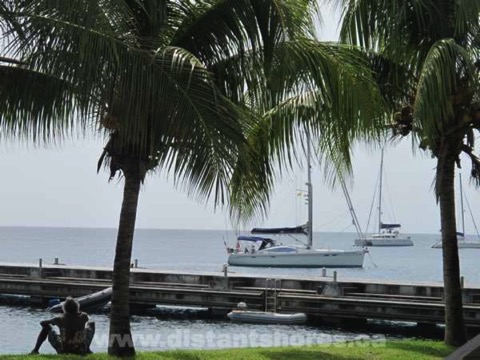
After a good beat across the Martinique Channel we arrived at the picturesque town of St. Pierre at the foot of the Mt. Pelée volcano at around 5:00 p.m. - just in time for sundowners in the cockpit.
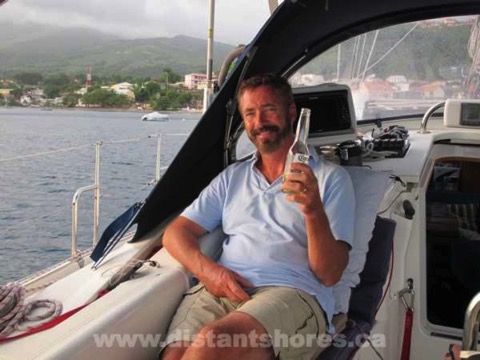
We anchored off the town quay leaving room for the ferry that comes to the quay. There is a shelf with comfortable depths of 3-8 m (10-25 feet) just off the town and then it drops off quickly to very deep water, so you need to be sure to get your anchor down securely on this shallow shelf. We anchored in 4 m (13 feet) with good holding. This is a good overnight anchorage except in heavy northerly swells.
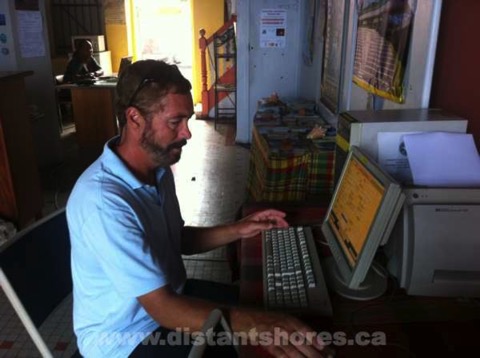
Clearing-in is done at the tourist office at the waterfront which is open Monday-Friday 9 a.m. to 2 p.m. so we waited and didn't go ashore until the next morning. The process is very easy and casual. There is a designated computer at the Tourist Office for Customs and Immigration and you fill in the documents yourself which require information from your ship's papers and crew passports. We brought all these documents with us since it's customary to show them to some kind of official but here it's the tourist office receptionist who welcomes you and she said she didn't need to see them. There were no administrative charges since it was a government office. We had the same experience in St. Martin and Guadeloupe, the other French Islands we've visited. In Deshaies in Guadeloupe, the DIY Customs and Immigration computer is in one of the local bars, so you can have a drink while you fill out the forms!
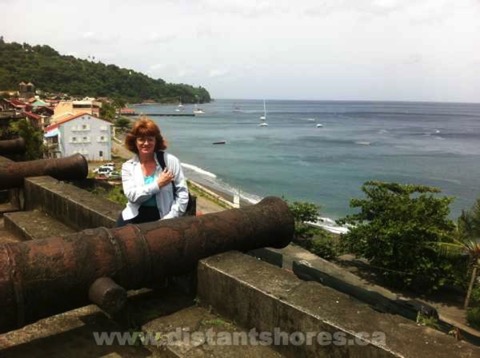
The history of St. Pierre is quite fascinating. In the late 1800's and early 1900's it was known as the “Paris of the Caribbean”. With a population of 30,000 people it was a prosperous town due to the success of the plantations surrounding St. Pierre. The shipments of rum, coffee, sugar and cocoa made several of the plantation owners multimillionaires. St. Pierre was the commercial, social and cultural centre of Martinique.
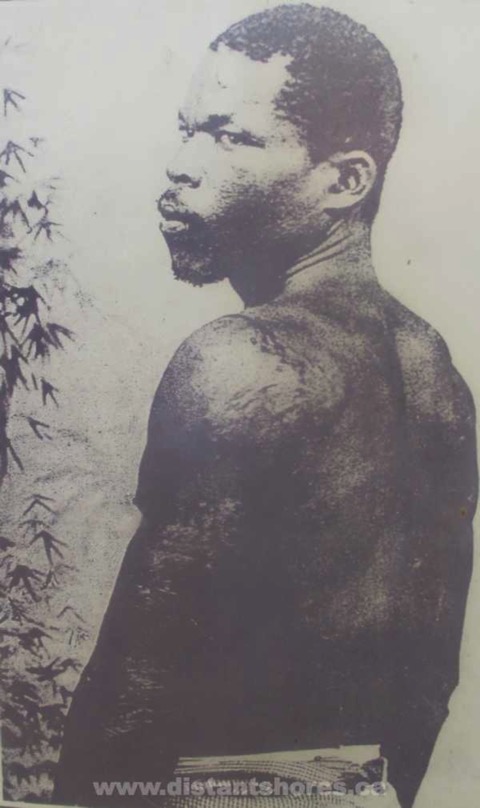
Cyparis, one of two survivors of the volcanic eruption of May 8 1902. He was later hired by the Barnum & Bailey circus.
But this ended abruptly when on Ascension Day, the 8th of May 1902, the Mt. Pelée erupted and a fireball with the explosive power greater than an atomic bomb blasted the town killing all but 2 people. One was a prisoner named Cyparis, imprisoned for murder in a stone cell. The thickness of the walls saved him but he was still badly burned.
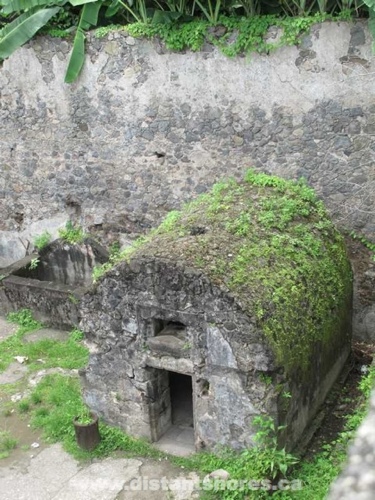
We visited the museum on the waterfront that tells the story in French and English, then visited the cell that Cyparis survived in for 3 days until he was found by rescuers.
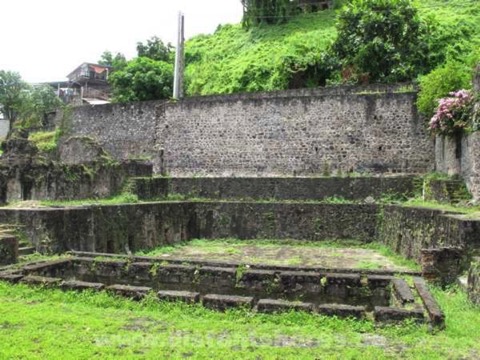
We also visited the remains of the once beautiful old theatre. Today the population of St. Pierre is about 5,000.
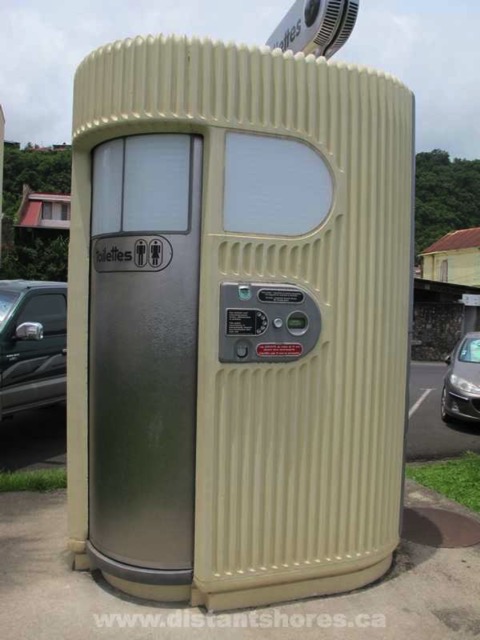
In French territories there are clean public washrooms everywhere. Here’s an example of coin-operated curbside toilettes.
Menu du Jour
You may recall that at this time last summer we were taking Distant Shores II through the canals of France. One of the things we enjoyed in France was that lunchtime is a sacred hour. Everything shuts down promptly for 1-2 hours at mid-day and people sit down to a proper relaxing meal. During the work week most restaurants offer a Menu du Jour (Menu of the Day) which has a starter, a main course, a dessert, and a glass of wine. Sometimes a cheese plate is included and tea or coffee. The Menu du Jour is excellent value so we were happy to discover that the same tradition is honoured in the French islands of the Caribbean.
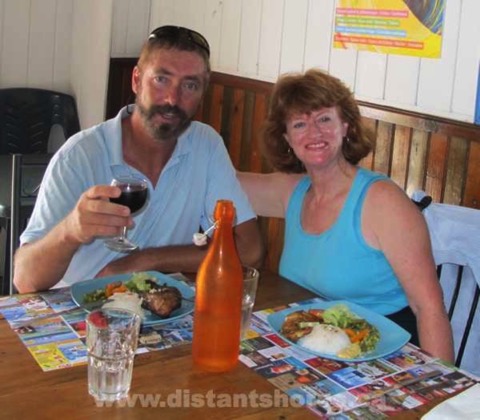
In St Pierre we enjoyed a delicious mid-day meal at a little restaurant close to the waterfront called Le Switch. It was quite plain looking from the street but it was full of working people, not just tourists, always a good sign. We were welcomed in warmly by the women running the restaurant and everyone sitting at tables gave us a friendly “bonjour” (good day) then helped explain in bits of French and English what the Menu du Jour was.
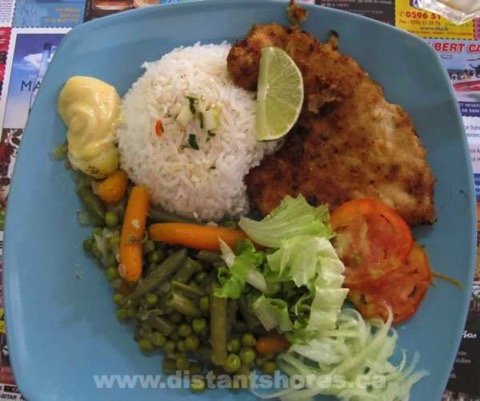
We had a choice of BBQ chicken or fresh-caught fish with sides, salad, dessert and a glass of wine. The cost of each 3 course meal was 8 euros (around $10 US), wine was extra, and we had fun watching and talking to the local people there. Everyone was laughing and joking and talking to one another the entire time. Such a great atmosphere! And the food was really good too. Cooked with love.
Wi-fi Woes
Internet access is pretty important to the cruising lifestyle these days, at least to those of us that communicate by e-mail and skype, do research and check weather forecasts online. Most cruisers maintain a blog, website and/or social media sites to keep folks at home updated on their whereabouts and adventures too. So our afternoon plan was to buy a voucher from the restaurant La Vague on the waterfront that advertised in our cruising guide that they offered an internet service for sailors at anchor. We'd seen the signal and should have been able to sign up for it on the boat via PayPal but the link wasn't working. The news wasn't good when we went in to the restaurant. The system was down and the person that usually looked after it was on vacation. There were no other internet cafes in town that we could find. In Dominica, we were able to get really good internet service on the boat through a service called Hot Hot Hot Spot which also covered islands further south. There were several other options too. We were going to the capital city of Fort-de-France the next day so decided that one day away from internet wouldn't be too bad.
Fort de France
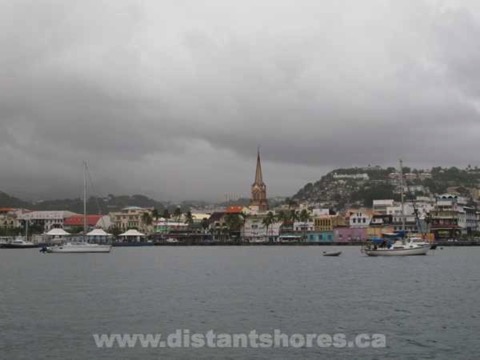
Tuesday June 18 we raised anchor and motored along the windless lee of the island from St Pierre to Fort de France where we anchored off the newly renovated waterfront of the city with a nice park and promenade and welcoming dinghy dock. In the anchorage were other boats we had seen up-island heading south like us. The southbound migration for Hurricane Season was underway.
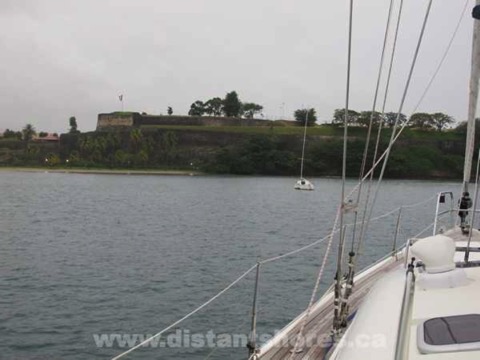
At our bow was Fort St Louis. Off our stern was a very modern skyscraper! It was such a shock to see it because, since arriving in the Caribbean in December, I don't think we've seen a building more than a few storeys tall. The anchorage was good except for the constant ferry wakes during the day.
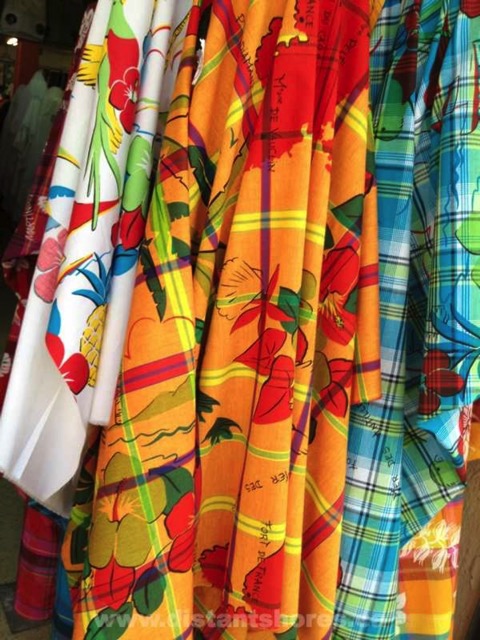
Beautiful fabric stores and fashion boutiques are a-plenty in the city of Fort-de-France
Our mission in Fort de France simply to get our wi-fi set up and do a bit of grocery shopping in the large supermarkets there. All we needed was a local Pay-as-You-Go data sim card for the Huawei E586 device that we use to connect to our computers for internet access onboard. It is a modem and portable local hotspot. Digicel is a Caribbean communications company that we had used in both St Lucia and the BVI with success so we went to the Digicel office to start the process. Well to make a long story short, we went back and forth to that store for 2 days and had no luck getting it to work. Our French isn't good and no one spoke English so that made things all the more difficult, I'm sure. In between we tried 3 internet cafes – none of them working or they only allowed you to use their computers which wouldn't work for the jobs we were sending. The only success we had was at the McDonalds on the waterfront right near the dinghy dock, not very satisfactory when we had a lot of things happening that required frequent back-and-forth correspondence. We didn’t want our time in Fort-de-France to spent sitting for hours in a McDonalds.
Fort de France to Ste Anne
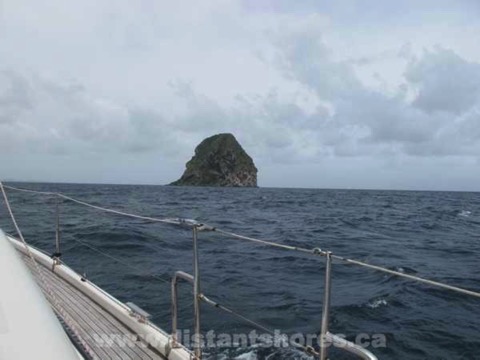
So on Thursday June 20 we raised anchor and left, internet free. How could a struggling country like Dominica have great wif-fi service and not the very developed sophisticated island of Martinique, a French department? Go figure. Getting out to sea helped us feel better. That is the great thing about sailing! It puts everything in perspective. It was a rougher sail than we expected as we rounded around to the south coast the strong headwinds.
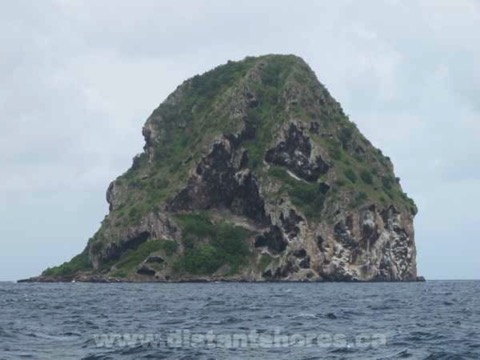
We passed the famous Diamond Rock that was captured by the British during the rule of Napoleon and named HMS Diamond Rock since they fired on French ships bringing supplies to Martinique. They held it for 18 months.
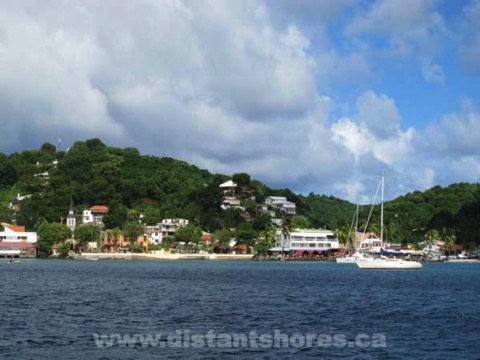
The seas and headwinds knocked down our speed so we arrived a little later than planned. But still time to go for drinks at the local internet provider, the restaurant La Dunette for 2 pina coladas (12 euros) to use the wifi. The ending to this story - their wi-fi didn’t work! Nor did it work in the 2 other internet cafes in town. It took days to repair. But now it’s flying like lightning and we are back in touch :-)
Until next time,
Sheryl and Paul
Aboard SV Distant Shores II
Ste Anne, Martinique
Comments